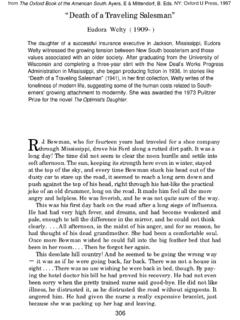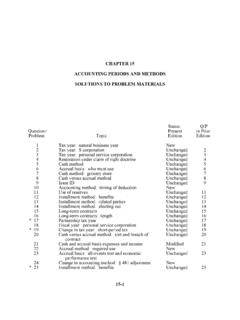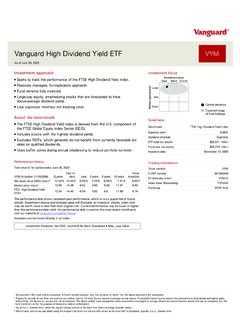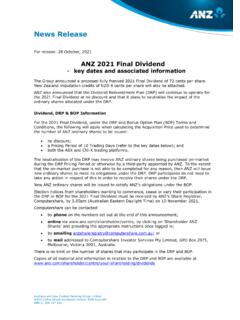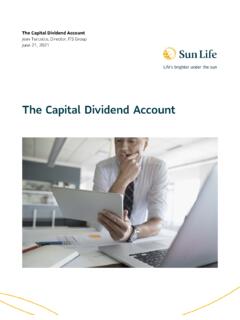Transcription of Corporations: Earnings & Profits & Dividend Distr.
1 Chapter 18 Chapter 18 Corporations: Distributions Not in Complete LiquidationCorporations: Distributions Not in Complete LiquidationEugene Willis, William H. Hoffman, Jr.,Eugene Willis, William H. Hoffman, Jr.,David M. Maloney and William A. RaabeDavid M. Maloney and William A. RaabeCopyright 2004 SouthCopyright 2004 South--Western/Thomson LearningWestern/Thomson LearningC18 - 2 Taxable DividendsTaxable Dividends Distributions from corporate Earnings and Profits (E & P) are treated as a Dividend distribution, taxed as ordinary income Distributions in excess of E & P are nontaxable to extent of shareholder s basis ( , a return of capital) Excess over basis is capital gain Distributions from corporate Earnings and Profits (E & P) are treated as a Dividend distribution, taxed as ordinary income Distributions in excess of E & P are nontaxable to extent of shareholder s basis ( , a return of capital)
2 Excess over basis is capital gainC18 - 3 Earnings & Profits (slide 1 of 2) Earnings & Profits (slide 1 of 2) No definition of E & P in Code Similar to Retained Earnings (financial reporting), but often not the same No definition of E & P in Code Similar to Retained Earnings (financial reporting), but often not the sameC18 - 4 Earnings & Profits (slide 2 of 2) Earnings & Profits (slide 2 of 2) E & P represents: Upper limit on amount of Dividend income recognized on corporate distributions Corporation's economic ability to pay Dividend without impairing capital E & P represents: Upper limit on amount of Dividend income recognized on corporate distributions Corporation's economic ability to pay Dividend without impairing capitalC18 - 5 Calculating Earnings & Profits (slide 1 of 4)Calculating Earnings & Profits (slide 1 of 4) Calculation generally begins with taxable income, plus or minus certain adjustments Add previously excluded items back to taxable income including: Munibond interest Excluded life insurance proceeds Federal income tax refunds Dividends received deduction Calculation generally begins with taxable income, plus or minus certain adjustments Add previously excluded items back to taxable income including.
3 Munibond interest Excluded life insurance proceeds Federal income tax refunds Dividends received deductionC18 - 6 Calculating Earnings & Profits (slide 2 of 4)Calculating Earnings & Profits (slide 2 of 4) Calculation generally begins with taxable income, plus or minus certain adjustments (cont d) Subtract certain nondeductible items: Related-party and excess capital losses Expenses incurred to produce tax-exempt income Federal income taxes paid Key employee life insurance premiums Fines and penalties Calculation generally begins with taxable income, plus or minus certain adjustments (cont d) Subtract certain nondeductible items: Related-party and excess capital losses Expenses incurred to produce tax-exempt income Federal income taxes paid Key employee life insurance premiums Fines and penaltiesC18 - 7 Calculating Earnings & Profits (slide 3 of 4)Calculating Earnings & Profits (slide 3 of 4) Certain E & P adjustments shift effect of transaction to year of economic effect, such as: Charitable contribution carryovers NOL carryovers Capital loss carryovers Certain E & P adjustments shift effect of transaction to year of economic effect, such as.
4 Charitable contribution carryovers NOL carryovers Capital loss carryoversC18 - 8 Calculating Earnings & Profits (slide 4 of 4)Calculating Earnings & Profits (slide 4 of 4) Other adjustments Accounting methods for E & P are generally more conservative than for taxable income, for example: Installment method is not permitted Alternative depreciation system required Percentage of completion must be used (no completed contract method) Other adjustments Accounting methods for E & P are generally more conservative than for taxable income, for example: Installment method is not permitted Alternative depreciation system required Percentage of completion must be used (no completed contract method)C18 - 9 Summary of E & P Adjustments Summary of E & P Adjustments Effect on taxable income for E & P: TransactionAddSubtractTax-exempt income XLife insurance proceeds XDeferred installment gain XExcess charitable contribution XDed.
5 Of prior excess contributionXFederal income taxes X Officer s life insurance premium X Accelerated depreciation XEffect on taxable income for E & P: TransactionAddSubtractTax-exempt income XLife insurance proceeds XDeferred installment gain XExcess charitable contribution XDed. of prior excess contributionXFederal income taxes X Officer s life insurance premium X Accelerated depreciation XC18 - 10 Current vs Accumulated E & P(slide 1 of 3)Current vs Accumulated E & P(slide 1 of 3) Current E & P Taxable income as adjusted Current E & P Taxable income as adjustedC18 - 11 Current vs Accumulated E & P(slide 2 of 3)Current vs Accumulated E & P(slide 2 of 3)
6 Accumulated E & P Total of all prior years current E & P as of first day of tax year, reduced by distributions from E & P Accumulated E & P Total of all prior years current E & P as of first day of tax year, reduced by distributions from E & PC18 - 12 Current vs Accumulated E & P (slide 3 of 3)Current vs Accumulated E & P (slide 3 of 3) Distinction between current and accumulated E & P is important Taxability of corporate distributions depends on how current and accumulated E & P are allocated to each distribution made during year Distinction between current and accumulated E & P is important Taxability of corporate distributions depends on how current and accumulated E & P are allocated to each distribution made during yearC18 - 13 Allocating E & P to Distributions (slide 1 of 3)Allocating E & P to Distributions (slide 1 of 3)
7 If positive balance in both current and accumulated E & P Distributions are deemed made first from current E & P, then accumulated E & P If distributions exceed current E & P, must allocate current and accumulated E & P to each distribution Allocate current E & P pro rata to each distribution Apply accumulated E & P in chronological order If positive balance in both current and accumulated E & P Distributions are deemed made first from current E & P, then accumulated E & P If distributions exceed current E & P, must allocate current and accumulated E & P to each distribution Allocate current E & P pro rata to each distribution Apply accumulated E & P in chronological orderC18 - 14 Allocating E & P to Distributions (slide 2 of 3)Allocating E & P to Distributions (slide 2 of 3)
8 If current E & P is positive and accumulated E & P has a deficit Accumulated E & P IS NOT netted against current E & P Distribution is deemed to be taxable Dividend to extent of positive current E & P balance If current E & P is positive and accumulated E & P has a deficit Accumulated E & P IS NOT netted against current E & P Distribution is deemed to be taxable Dividend to extent of positive current E & P balanceC18 - 15 Allocating E & P to Distributions (slide 3 of 3)Allocating E & P to Distributions (slide 3 of 3) If accumulated E & P is positive and current E & P is a deficit, net both at date of distribution If balance is zero or a deficit, distribution is a return of capital If balance is positive, distribution is a Dividend to the extent of the balance If accumulated E & P is positive and current E & P is a deficit, net both at date of distribution If balance is zero or a deficit, distribution is a return of capital If balance is positive, distribution is a Dividend to the extent of the balanceC18 - 16 Cash Distribution ExampleCash Distribution ExampleA $20,000 cash distribution is made in each independent situation.
9 1 2 3* Accumulated E & P, beginning of year 100,000 (100,000) 15,000 Current E & P 50,000 50,000 (10,000) Dividend : 20,000 20,000 5,000*Since there is a current deficit, current and accumulated E & P are netted before determining treatment of $20,000 cash distribution is made in each independent situation:1 2 3* Accumulated E & P, beginning of year 100,000 (100,000) 15,000 Current E & P 50,000 50,000 (10,000) Dividend : 20,000 20,000 5,000*Since there is a current deficit, current and accumulated E & P are netted before determining treatment of - 17 Property Dividends(slide 1 of 4)Property Dividends(slide 1 of 4) Effect on shareholder: Amount distributed equals FMV of property Taxable as Dividend to extent of E & P Excess is treated as return of capital to extent of basis in stock Any remaining amount is capital gain Effect on shareholder.
10 Amount distributed equals FMV of property Taxable as Dividend to extent of E & P Excess is treated as return of capital to extent of basis in stock Any remaining amount is capital gainC18 - 18 Property Dividends(slide 2 of 4)Property Dividends(slide 2 of 4) Effect on shareholder (cont d): Reduce amount distributed by liabilities assumed by shareholder Basis of distributed property = fair market value Effect on shareholder (cont d): Reduce amount distributed by liabilities assumed by shareholder Basis of distributed property = fair market valueC18 - 19 Property Dividends(slide 3 of 4)Property Dividends(slide 3 of 4) Effect on corporation: Corp. is treated as if it sold the property for fair market value Corp.
